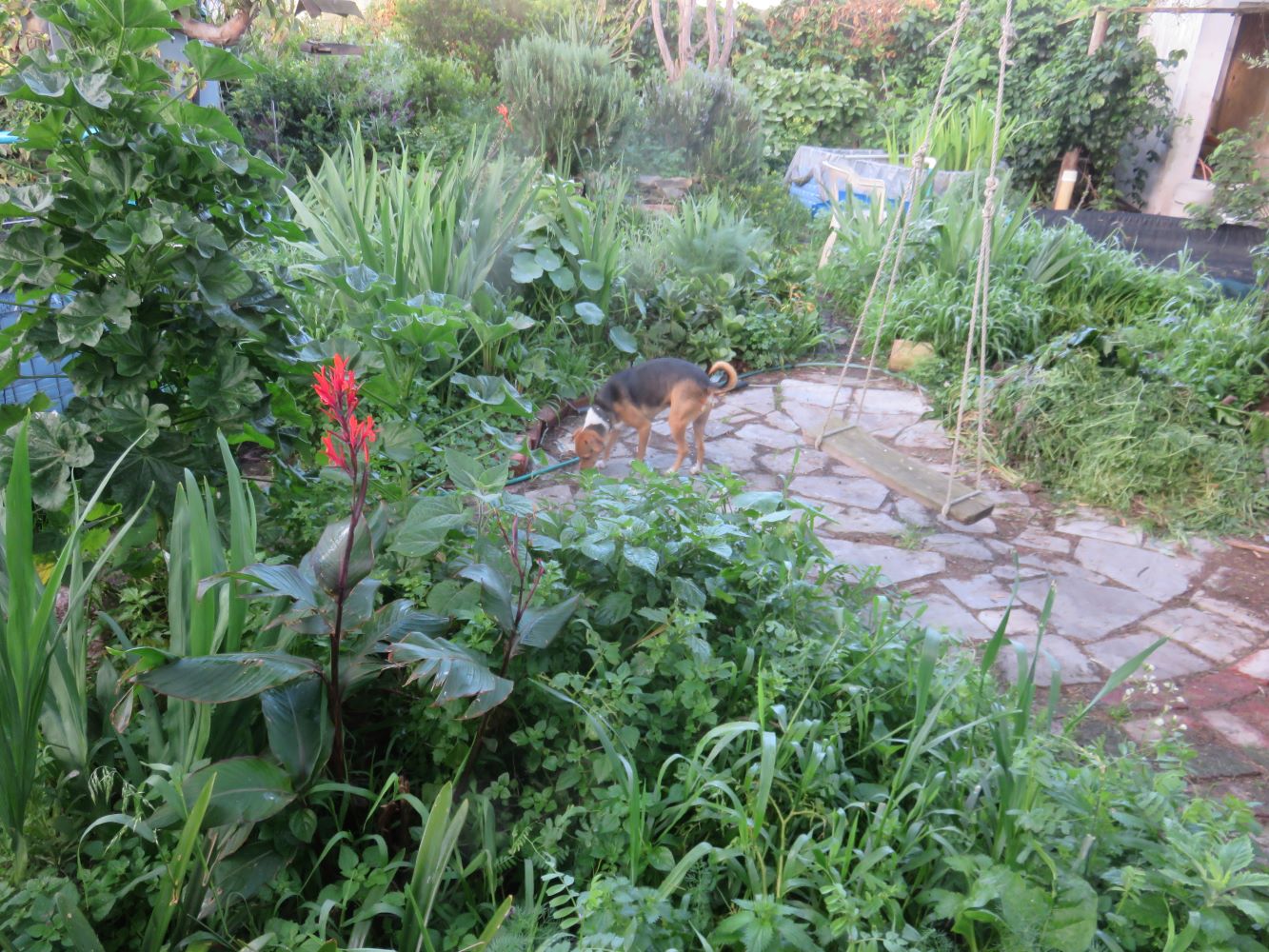Dear Reader, in this age of AI created content, please support with your goodwill someone who works harder to provide the human-made. Sign up in the righthand column or bottom of this page. You will receive my hand illustrated monthly newsletter RESTORE NATURE and access to the biodiversity garden design course as I write...and nothing else, I respect your time.
Growing mushrooms:
an introduction to three workshop albums on spawn and using straw and logs
A while back I was introduced to growing mushrooms when I attended the Guerilla House workshop entitled ‘low tech shrooms’.
As it states, the workshop equips one with the knowledge to grow mushrooms without the high tech controlled equipment used in commercial production. For a permaculturist the low tech part is good news, not just because its cheaper for a beginner, but because one is going to end up growing mushrooms which are adapted to your garden. The loss in yield compared to commercial production is compensated for by using mushrooms for ecosystem creation.
The very basics of
growing mushrooms
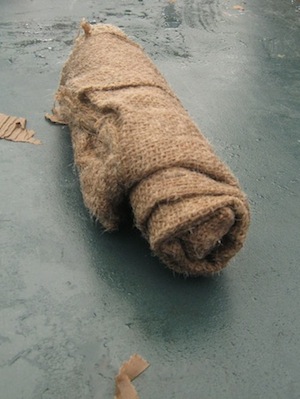 spawn sacks can be colonized with mycelium which spreads to their contents when filled
spawn sacks can be colonized with mycelium which spreads to their contents when filledIn mushroom growing there are generally two processes. First one cultivates spawn, or mycelium on some medium and then one uses this to inoculate the growth medium on which the mushroom fruit will eventually appear. We learned about propagating spawn straight from mushrooms bought at the grocers, using their spore dust or their stalks. This first growth, the making of spawn, uses media like rice, sawdust, corrugated cardboard, burlap sacks and wooden dowels, and we were given something to practice on at home (an oyster mushroom cocooned in cardboard). Then we learned about growing mushrooms on straw and logs, and practiced on real materials present, inoculating them with preprepared oyster ‘spawn’ consisting of wood chips completely overgrown with oyster mycelium, and wooden dowels which also were covered with mycelium. I say covered loosely. The mycelium penetrates through the wood and substance of the spawn. We thus engaged, hands on (or should I say rubber gloves on) with the whole process from start to finish, but we’ll have to wait and see what happens with our own first efforts. Here is something on my attempts to grow mushrooms at home in the bathroom and in beds outside in the garden.
The albums and articles on growing mushrooms to follow
I’ve divided the huge photo album from the workshop in three. There is one on spawn, one on using straw as a pure growth medium, or in beds in the garden, and another on using logs and closing with other pictures which were hard to group. Sometime in the unforeseeable future I will follow these three articles with more mushroom pages based on Paul Stamet’s book and the fantastic learning kickstart I got from this Guerilla House workshop.
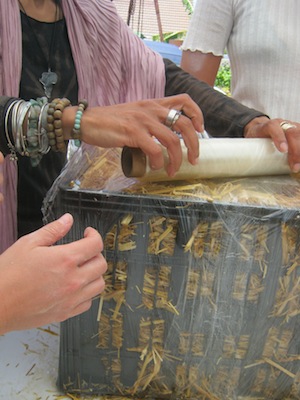 growing mushrooms on straw, protecting the medium
growing mushrooms on straw, protecting the mediumLearning about mushrooms
So I came away from the workshop with a lot of photographs, the Guerilla House manual on mushroom growing, Paul Stamets book Mycelium Running, suggestions on videos to watch, the taste of a great oyster mushroom stir fry for lunch lingering on the tongue and an oyster mushroom encased in pasteurized cardboard.
The learning curve at the workshop steepened as I opened my front door. The oyster mushroom in its cardboard cocoon, I was supposed to remove after 24 hours and then use the cardboard to inoculate another growing medium to make more spawn. I missed the part that I was to use the cardboard LATER, and not at the time of removing the mushroom !
When I lifted the mushroom the cardboard was traced with a reticulated pattern of white threads. The oyster mycelium spreading out from its invisible spore dust was aggressively colonizing the cardboard after only a few hours. Despite using disposable surgical gloves when tearing up the cardboard and placing it in jars of cooked rice, some gray-green mold has dogged the process, popping up its head whenever I think I’ve cut it off ! I think I know part of the reason now, after rereading the manual.
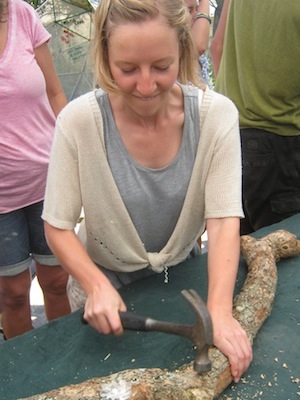 growing mushrooms on logs: hammering in dowel spawn
growing mushrooms on logs: hammering in dowel spawnGuerilla House workshops are dense with information, and I ended up missing something important. I should have left the oyster mycelium to colonize a substantial amount of the cardboard, instead I tore it up when it was still vulnerable to competition. Once in the jars of rice, something white, the oyster mushroom no doubt, grew apace out from the cardboard, but so did blue gray molds. I had not given the oyster a chance to get a good ‘foothold’ before drowning it in a nutritious medium contaminated with competitors. However, after the mold in the bottles had grown for some days and the rice was bound up in mycelium, we unbottled it, cut out all the gray-green we could see, mixed it with fermented straw and packed it tight in a bag with some tiny airholes. Lo and behold, the culture in the bag is also 50% gray-green mold.
Things are in a liminal state of growth here with mushroom knowledge. Not least because Paul Stamet’s book, sent with Guerilla House’s free downloads just stopped me in my tracks and started rearranging my little knowledge ecosystem. I’m completely unsettled. The wood for the trees ? The mushroom does not grow IN the forest, the FOREST grows in the mushroom. I have been reading Mycelium Running for days instead of writing. I’ve been sharing stuff I’ve learned with an online friend studying innovative agriculture in Uganda. Excitement grows like exploding pinheads popping out of ‘rotten’ (a judgmental term I see now) wood.
Absolutely fungamental !
We ignore fungi in day to day life. Fungus is a derogatory term in many ways. As with so many of the things we ignore, even despise, we do so because we are overwhelmed by or unconscious of and cannot assess an alternative explanation, or paradigm or reality or universe.
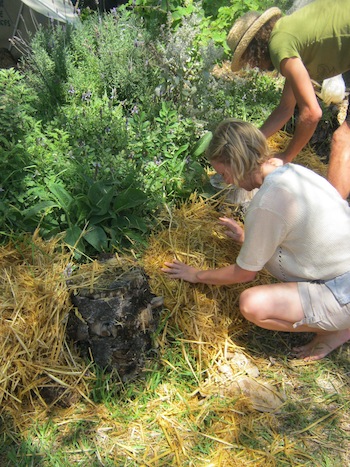 Taking mushrooms out there, planting them in the garden
Taking mushrooms out there, planting them in the gardenFungi are the
bedrock of life, that’s it, not some strange and rare outgrowths found in dark
quiet lonely places. Its hard to get the head around that one. They are the key
to the concept I was searching for to explain fertility. The ancients should
have built temples to the mushroom rather than the moon. They are the reason so
much carbon needs to be put in the ground to create soil and save water. They
eat carbon compounds, but also a number of things other micro-organisms can’t
digest, from rocks to lignin and petrochemicals. They cannot be ignored, and
yet they are. They could be used to keep tomato blight and fruit fly at bay.
That is enough to blow my mind.
I’m surprised it took so little to make me not only a fungophile but mycomad. I’ve always thought such people were new agey and shoo wa wa and now I’m one of the tribe… oh dear oh dear… time to sit down old bid, and have a cuppa… mushroom tea ?
However, let us get away from Paul Stamets and back to the Guerilla House workshop. Move on to the album on spawn, or the ‘growing mushrooms on straw’ album or the one about growing oyster mushrooms on logs. The albums all go stage by stage through the process with annotated photographs, but there was so much to learn, I can't do it all justice with pictures.
------
home page for links to lots of information on natural gardening
------
vegetable gardening and tips on easy vegetables to grow
You’re a home gardener ! Share your experiences and questions !
We all know about home gardening. Tell us about your successes, challenges and ask about issues that bother you. You may have the luxury of a back garden, but there are other ways we learn. Few people age without growing something or buying vegetables during their lives ! It is absolutely guaranteed that you have learned things which can help others on their gardening journey.
We invite you to share your stories, ask questions, because if a thing has bothered you it will bother others too. Someone may have a solution ! No question is too small. There is learning for everyone involved, for you, for me (yes, I learn from every question), for us all. Exciting stuff !
We are starting on a new journey. Every week we will profile your letters ! The best stories and questions we receive.
Restore Nature Newsletter
I've been writing for four years now and I would love to hear from you
Please let me know if you have any questions, comments or stories to share on gardening, permaculture, regenerative agriculture, food forests, natural gardening, do nothing gardening, observations about pests and diseases, foraging, dealing with and using weeds constructively, composting and going offgrid.
What Other Visitors Have Said
Click below to see contributions from other visitors to this page...
Fanie 




Quote - They could be used to keep tomato blight and fruit fly at bay. That is enough to blow my mind. End quote.
If you mind hasn't been blown (up …
SEARCH
Order the Kindle E-book for the SPECIAL PRICE of only
Prices valid till 30.09.2023
Recent Articles
-
garden for life is a blog about saving the earth one garden at a time
Apr 18, 25 01:18 PM
The garden for life blog has short articles on gardening for biodiversity with native plants and regenerating soil for climate amelioration and nutritious food -
Cape Flats Sand Fynbos, Cape Town's most endangered native vegetation!
Apr 18, 25 10:36 AM
Cape Flats Sand Fynbos, a vegetation type found in the super diverse Cape Fynbos region is threatened by Cape Town's urban development and invasive alien plants -
Geography Research Task
Jan 31, 25 11:37 PM
To whom it may concern My name is Tanyaradzwa Madziwa and I am a matric student at Springfield Convent School. As part of our geography syllabus for this
"How to start a profitable worm business on a shoestring budget
Order a printed copy from "Amazon" at the SPECIAL PRICE of only
or a digital version from the "Kindle" store at the SPECIAL PRICE of only
Prices valid till 30.09.2023

